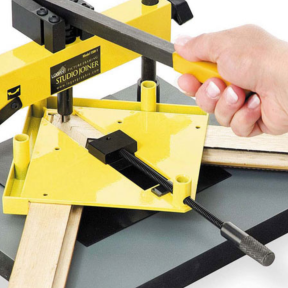Time Needed: 2-10 min.
Difficulty Level: Easy
Materials Needed
-Measuring Tools
-A calculator (or paper and pencil
-Selected Picture Frame Moulding(s)
Once you choose your specific mouldings, you’ll be using the width of the frame in determining your needed length.
Frame width can be found in each moulding description on the Framing 4 Yourself website.
Calculating the Length of Moulding Needed for Your Project
For a quick estimate, try our Moulding Length Calculator!
Step 1. Know the Inside Dimensions of Your Frame(s)
The inside dimension of your frame will be your art size – plus any matboard if applicable.
The guide for determining your frame size can be found here.
If you’ve never ordered length moulding before, it’s helpful to list out your frame dimensions like the example below:
Ex. You want to make 2 frames at 11” x 14”
–11 1/8” + 11 1/8” + 14 1/8” + 14 1/8” = 50 ½”
–11 1/8” + 11 1/8” + 14 1/8” + 14 1/8” = 50 ½”
Don’t forget that you’ll need to add an 1/8” to your inside dimensions to create an appropriate allowance for fitting your art.
Please note: For floater frames you need to add the amount of floating space you want to have between your canvas and your frame instead of 1/8”.
Now you’ll need to add your moulding width with the formula shown in step 2 to get the minimal footage required for your picture frame (step 3 will explain yield and provide some suggested wiggle room allowances)
Step 2. Using Your Moulding Width to Help Calculate Footage Needed
Your moulding width will need to be multiplied by 8 to account for each mitered edge of a finished frame, and then added to the total internal dimension that you calculated above.
Ex. Your 2 frames at 11” x 14” use a 1 ¼” wide moulding
-1 ¼” x 8 = 10”
–1 ¼” x 8 = 10”
Adding this number to the totals from Step 1 will provide you with your minimal footage required.
Ex. You want to make 2 frames at 11” x 14” using 1 ¼” wide moulding
–50 ½” + 10” + 50 ½” + 10” = 121” (or 10’ 1” of moulding)
See Step 3 for helpful hints regarding yield & variability.
The chart below has some frame widths pre-calculated for your reference.
| Moulding Width | Length Added to Your Frame Dimensions |
| 1” | 8” |
| 1 ½” | 12” |
| 2” | 16” |
| 2 ½” | 20” |
| 3” | 24” |
Step 3. How Yield Affects Your Length Order and Accounting For Product Variability
In addition to accounting for stick length in your yield, it’s recommended to account for some extra moulding to accommodate:
-Any miscuts (happens to the best of us!)
-Grain / Finish variation in natural woods
-Lining up patterns in ornate moulding
Framing 4 Yourself can send length moulding at a maximum of 7’ long for ground shipping services so we offer various cut bundle packages to accommodate various project sizes & yield.
We offer cut, 1 stick bundles (8’ standard, but if a stick is longer than 8’ you still receive the rest of the stick – or balance – of the remaining moulding you purchase):
-7’ & 1’ or balance
-6’ & 2’ or balance
-5’ & 3’ or balance
-4’ & 4’ or balance
As well as larger, multi-stick bundles cut to 7’ and balance.
For 2 frames at 11×14 needing at least 10’1″, you can choose a cheaper 14′ bundle (leaving four 1′ scraps), or spend more on two 8′ bundles (cut into 4′ each), leaving you with a useful 4′ leftover for your next project.
FAQ’s
Why are you Adding the Width of the Moulding times 8 to the Frame Size?
When building a picture frame, you will miter the ends of each section to create the angles that, when fitted together, will form a corner.
Each one of the eight miters needed to make the four corners will be equivalent in the length to the width of the frame across its face.
So if the frame is 1″ wide, you will need enough moulding to make the four sides as well as 1″ x 8 to account for the miters. If the frame is 2″ wide, you will need 2″ x 8 = 16″ to account for the miters.
Why are you Adding 1/8″ to the Length to Account for “Wiggle Room”?
If you build the frame to exactly 11″x14″, the components won’t fit properly inside. They’ll end up bending or warping.
If they are off by just a hair, they won’t fit. In picture framing parlance, the wiggle room we build into the frame is called the “allowance”, and every picture framer builds an allowance into his or her frame. Typically, the allowance is an additional 1/16″ along each side. To build in a 1/16-inch allowance on each side, you only need to account for the length and width, two dimensions total. That means adding 1/8″ to both the length and width of your frame, which gives you 1/16″ of wiggle room on each side for your art and components.
Need more help? Contact info@framing4yourself.com.











I need to fit a 4ft X 4ft peice of plexiglass to make a frame.
What size should I buy?
I apologize for the delay – your note was caught in our spam folder. The piece of plexiglass depends on the size of the artwork you are framing. If you are framing a 36″ x 36″ piece of art, you would need a 36″ x 36″ piece of acrylic.
Best,
Framing4Yourself.